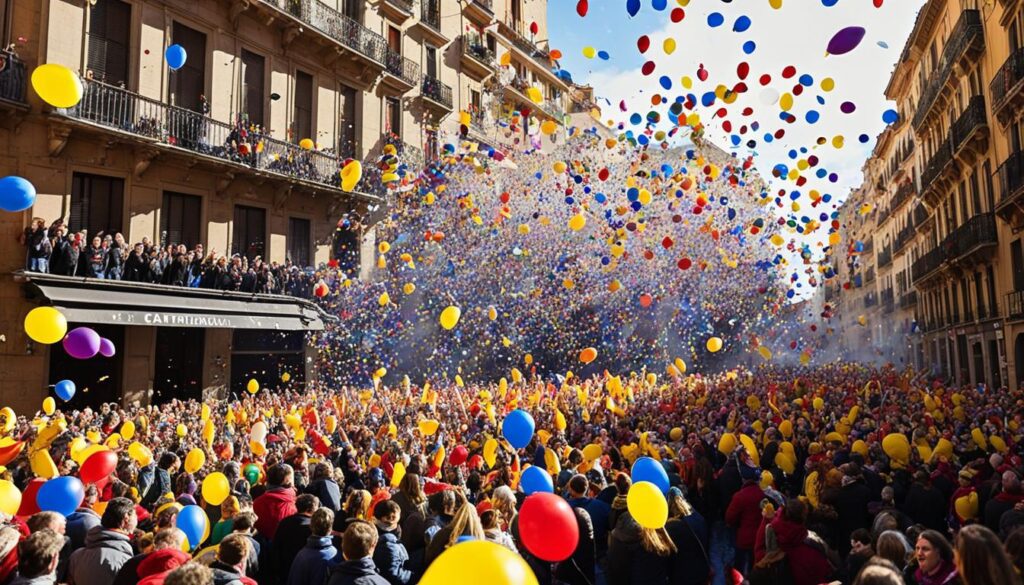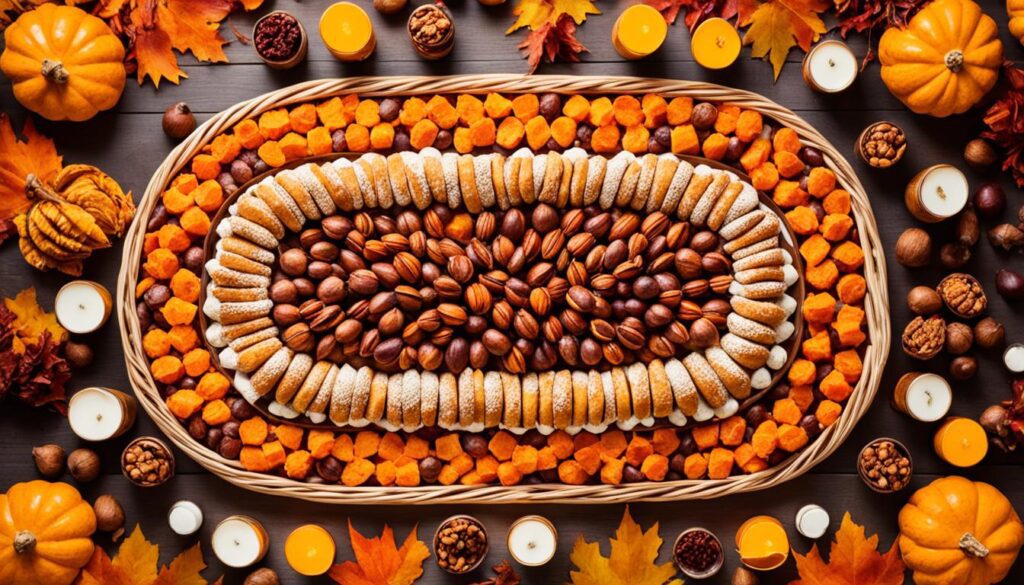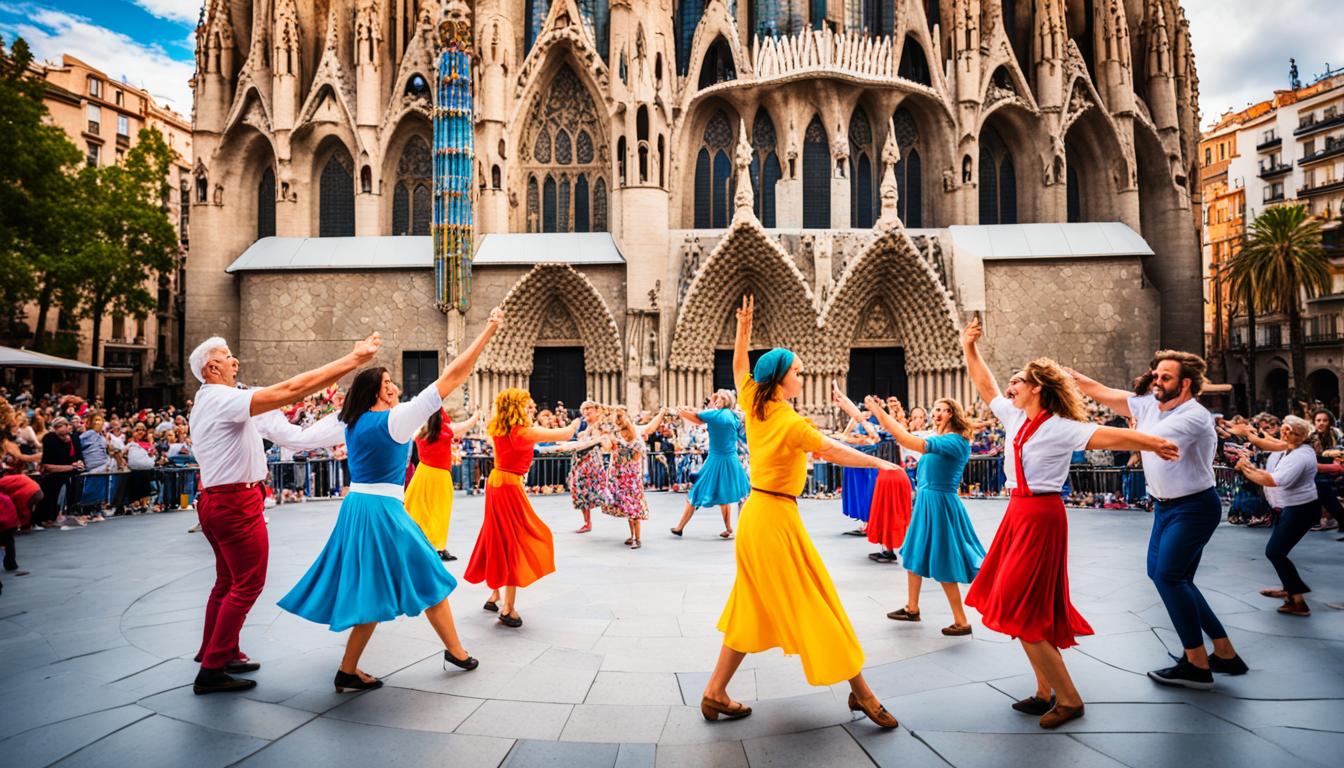Barcelona is a top spot in Europe for culture, known for its rich Catalan traditions. It draws visitors with its stunning architecture by Antoni Gaudí and the vibrant Catalan festivals. This city mixes Spanish and Catalonian culture in a way that’s truly magical.
There’s more to Barcelona than just the famous Sagrada Familia and La Rambla. It’s a place where culture comes alive in its food, language, and festivals. Let’s explore the world of Catalan culture and see why Barcelona is so special.
Key Takeaways
- Barcelona is a cultural center in Europe, blending Spanish and Catalan influences.
- Catalan cuisine, language, and festivals are integral to the city’s unique identity.
- Iconic landmarks like the Sagrada Familia and La Rambla are complemented by a rich cultural heritage.
- Visitors can immerse themselves in Catalan traditions, from traditional dishes to lively celebrations.
- Barcelona’s thriving cultural scene offers a one-of-a-kind experience for travelers.
Catalan Culture: A Distinct Identity
Catalonia is a special part of Spain with its own rich culture. At the core of this uniqueness is the Catalan language. Most people there speak it and take great pride in it.
Catalan Language: A Proud Heritage
Even when the Franco regime tried to suppress it, the Catalan language survived. Today, it’s a key part of daily life, education, and government. This shows the strength of Catalonia’s cultural identity, shaped by a long history.
Autonomous Community: Catalonia’s Unique Status
Catalonia has a special status within Spain, which has shaped its politics and culture. Debates on Catalan independence highlight its distinctiveness. Groups work hard to keep Catalan culture alive, especially in tough times.
For centuries, Catalonia has kept its culture separate, with its own politics and talks with the Spanish monarchy. This history of autonomy has made the Catalan nation what it is today.
“Catalonia has a rich historical background that dates back to the Roman Empire’s rule, which granted citizenship to people in the region and saw significant infrastructure development.”
Iconic Catalan Cuisine
Catalonia’s food scene celebrates its coastal and mountainous beauty. It offers a mix of seafood from the Mediterranean and hearty meats from the Pyrenees. Dishes like pa amb tomaquet, crema catalana, and various sausages and stews are famous worldwide.
Pa amb Tomaquet: The Beloved Bread and Tomato Dish
Pa amb tomaquet is a key Catalan dish. It’s made with fresh ingredients. The dish has toasted bread rubbed with a ripe tomato, topped with olive oil, and sprinkled with salt.
It’s enjoyed as a snack, side dish, or a light meal. This dish shows how simple ingredients can create something amazing in Catalan cuisine.
Crema Catalana: The Decadent Custard Delight
Trying crema catalana is a must when exploring Catalan food. It’s like the French crème brûlée but with a caramelized sugar top and a smooth inside. This dessert is loved for its sweet and creamy taste.
Catalan food also includes botifarra sausage, escudella stew, and fideua noodles. These dishes mix tradition with new tastes. Enjoying pa amb tomaquet or crema catalana shows the passion for food in Catalonia.
Vibrant Catalan Festivities
Catalonia is famous for its lively celebrations and festivals. These events bring the region’s culture to life. In Barcelona, the La Mercè festival in September is the biggest and most vibrant celebration. It started as a religious festival for the Virgin of Grace but now includes many Catalan traditions.
These traditions include castellers (human towers), the Catalan wine fair, and traditional dances like the sardana. The festival also has music, fireworks, and the exciting “correfoc” (fire run). This creates a lively atmosphere that draws in both locals and visitors.
La Mercè: Barcelona’s Biggest Street Party
The La Mercè festival celebrates Catalan identity and heritage. It happens every September and draws millions of people. They come to see the castellers (human towers), sardana dances, and the “correfoc” (fire run). These events show off Catalonia’s rich traditions.
There’s more than just culture at La Mercè. There’s also a Catalan wine fair. Visitors can try local wines and enjoy the friendly vibe in Barcelona’s streets during this time.
“The La Mercè festival is a true celebration of Catalan identity and heritage, attracting millions of attendees who come to experience the vibrant displays of Catalan culture.”
La Mercè also has music concerts, fireworks, and entertainment for all ages. Its wide range of activities makes it a key event for those wanting to dive into catalan festivals and barcelona street parties.
barcelona culture
Barcelona is the vibrant capital of Catalonia, blending Spanish and Catalan cultures. It has a unique identity. The city is part of Spain but has its own language, traditions, and art. This lets it keep its culture special, different from the rest of Spain.
Catalonia’s culture is seen in Barcelona’s architecture, like Antoni Gaudí’s works. The city’s festivals and the Catalan language show its pride. This language is spoken by most people there and is a key part of its identity.
Barcelona’s culture shines in its food, with over 20 Michelin-starred restaurants. The city’s music festivals, like Sónar and Primavera Sound, are famous worldwide. They show the city’s wide range of music.
Public art is big in Barcelona, with sculptures and graffiti everywhere. The city’s museums, like the National Museum of Art, show off Catalan and Spanish art. They cover everything from ancient to modern art.
Barcelona celebrates Catalan traditions like dancing giants and the sardanas dance all year. The city’s famous buildings, like the Sagrada Familia, show its unique culture. They make Barcelona a top cultural spot.
Barcelona’s culture is a mix of Spanish and Catalan, offering a memorable experience. Whether you’re walking through the Gothic Quarter or enjoying a festival, you’ll feel the city’s strong culture. It shows how important it is to keep local traditions alive in a big country.
| Iconic Catalan Culture | Highlights |
|---|---|
| Architecture | – Sagrada Familia by Antoni Gaudí – Other Catalan Modernisme buildings – Barcelona won the prestigious 1999 RIBA Royal Gold Medal for its exceptional architectural contributions |
| Cuisine | – Over 20 Michelin-star restaurants in Barcelona, indicating a high culinary standard – Diverse dining options from tapas to Michelin-starred restaurants |
| Music and Festivals | – Vibrant music scene with festivals like Sónar, Barcelona Jazz Festival, and Primavera Sound – The Barcelona Symphony and Catalonia National Orchestra (OBC) is the largest symphonic orchestra in Catalonia |
| Public Art | – Abundance of sculptures, installations, and graffiti in public spaces – Showcasing the city’s commitment to cultural expression |
| Traditions and Celebrations | – Cultural celebrations like dancing giants, human pyramids, and sardanas dance – Unique Catalan traditions that have been preserved and celebrated |
Barcelona’s culture shows the importance of keeping local traditions alive. The city’s unique blend of Spanish and Catalan makes it a special place. It’s known for its language, traditions, and art, making it a must-see destination.
Sant Jordi: A Day of Love and Literature
In Catalonia, Sant Jordi’s Day on April 23rd is a big deal. It’s like Catalan Valentine’s Day. It celebrates Sant Jordi, a hero who killed a dragon to save a princess.
On this day, men give women a rose, and women give men a book. This started in the 1920s. It’s a way to honor love and literature. The date also marks the deaths of famous authors Miguel de Cervantes and William Shakespeare.
Barcelona’s streets are filled with rose and book sellers. They line the famous La Rambla. It’s a time of joy and romance.
The Legend of Sant Jordi
The story of Sant Jordi is about a brave knight saving a princess from a dragon. This story shows love and courage in Catalan culture. Sant Jordi has been celebrated since the 8th century. Many places are named after him.
Book and Rose Exchange Tradition
The tradition of giving books and roses started long ago. In 1456, the Catalan Parliament made Sant Jordi a special day. Every year, millions of roses and books are sold during this time.
“The tradition of exchanging gifts of books and roses on Sant Jordi Day dates back to the early 20th century.”
In 2016, Barcelona was named a UNESCO City of Literature. It joins cities like Edinburgh and Krakow in the UNESCO Creative Cities Network. The idea of giving books on Sant Jordi came from International World Book Day, which started in Spain in 1923.
Catalan Carnival Celebrations
Barcelona’s catalan carnival has a long history, starting in the 14th century. The first mention of carnival in barcelona was in 1333 by the City Council, Consell de Cent. This shows how deep the tradition of catalan carnival traditions runs in the area.
Over time, the catalan carnival has changed, with each neighborhood having its own event. From the food-filled Fat Thursday to the Carnival King’s parade on Sunday, it’s a big cultural event.
In the 19th century, the Barcelona catalan carnival became more popular thanks to The Born Society. But during the Franco regime, the carnival was banned. It wasn’t celebrated again until 1980.
Now, the Barcelona catalan carnival is a big event that gets everyone involved. It starts with Jueves Lardero and ends with the Burial of the Sardine on Ash Wednesday. The catalan carnival includes the arrival of the Carnival King and Orangeade festivities.
Today, the catalan carnival in Barcelona brings together troupes, bands, and locals for neighborhood events. This keeps the tradition alive and well.

“The Barcelona Carnival is a vibrant and lively expression of the region’s cultural heritage.”
The catalan carnival in Barcelona has changed, but its heart remains the same. It shows the strength and pride of the Catalan people.
Castellers: The Human Tower Tradition
In Catalonia, the tradition of castellers, or human towers, is a key cultural highlight. People of all ages work together to build tall structures by stacking on each other. This shows their balance, coordination, and teamwork.
This tradition started in the 18th century and is now a key part of Catalan identity. In 2010, UNESCO named castellers an Intangible Cultural Heritage of Humanity. This shows how special it is to Catalonia.
UNESCO-protected Cultural Heritage
The biggest castellers events happen during the Feast of Mercè in Barcelona. Here, groups show off their skills in Sant Jaume square. Spectators watch in awe as towers up to 10 levels high are built.
Castellers have a long history in Catalan culture, over 200 years. In Barcelona, there are six main teams, each with their colors and uniforms. The tradition has spread, with groups performing all over Catalonia.
The castellers tradition shows the unity and strength of the Catalan people. Its motto, “Força, equilibri, valor i seny” (Strength, balance, courage, and common sense), reflects the values behind this unique practice.
Diada de Catalunya: Catalonia’s National Day
September 11th is a big day for Catalonia, known as the Diada de Catalunya. It’s a day to remember the region’s history and its unique culture in Spain. The day remembers when the Catalan forces lost to the Spanish army in the War of Succession in 1714.
This loss happened during the Siege of Barcelona. The Diada de Catalunya now celebrates the strength and pride of the Catalan people. People come out in large numbers to enjoy parades, concerts, and to show support for Catalan independence.
Commemorating the Siege of Barcelona
The Siege of Barcelona in 1714 is a key event in Catalan history. Catalan forces, led by General Rafael Casanova, fought bravely against the Spanish army. Even with great effort, they were defeated, and Barcelona was taken by the Spanish.
Today, the Diada de Catalunya honors this struggle. Monuments to General Casanova and other heroes are found across the region. The day includes ceremonies and calls for Catalan freedom.
The Diada de Catalunya has changed from a day of mourning to a celebration of Catalan identity. During the Francoist dictatorship, it was banned, but it was brought back in 1976 with democracy’s return. Since then, it has grown in popularity, with big demonstrations showing support for Catalan culture.
“The Diada de Catalunya is a testament to the resilience and pride of the Catalan people.”
Events like a 250-mile human chain in 2013 and a giant “V” symbol in 2014 show the power of the Diada de Catalunya. It’s a symbol of Catalonia’s culture and politics. This holiday brings people together, celebrating the Catalan spirit and the fight for independence.
La Castanyada: Honoring the Deceased
In the United States, Halloween is a big deal. But in Catalonia, there’s a special festival called La Castanyada. It’s a time to honor the dead and enjoy traditional foods like chestnuts, sweet potatoes, and panellets in Barcelona.
La Castanyada started in the 19th century. Back then, church bells rang to remember the dead, and people ate these foods to stay warm and happy. Now, it’s a key part of Catalan culture. You can find the “Brazil nut lady” selling treats and see parades with giant figures.
Chestnuts and Panellets: Traditional Treats
Here are the foods you’ll find at La Castanyada:
- Roasted chestnuts
- Marzipan balls known as panellets
- Roasted sweet potatoes
- Candied fruit
- Quince
- Ossos de sant (saint’s bones cookies)
- Sweet Muscatel wine
In Barcelona, you can buy hot chestnuts from vendors in October. They cost about three to four euros for a dozen. Bakeries also offer castanyada sweets and sometimes run raffles to draw in customers.

La castanyera, an older woman who roasts chestnuts, is a symbol of the holiday. In Barcelona, events mix La Castanyada with Halloween, giving everyone a special experience.
Gothic Quarter: Barcelona’s Medieval Heart
The Gothic Quarter, or Barri Gòtic, is in the heart of Barcelona. It takes visitors back to the city’s medieval times. This area has narrow streets, Gothic-style buildings, and historical spots. It shows off the Catalan architecture and culture that make Barcelona special.
The Barcelona Cathedral is a key spot in the Gothic Quarter. It’s a beautiful example of Gothic architecture with detailed facades and tall spires. Nearby, Plaça del Rei and Plaça Sant Jaume are lively places for events and celebrations. They give a peek into medieval Barcelona.
Walking through the Gothic Quarter, you’ll find hidden spots. There are small shops, historic eateries, and bars. The area is also known for its artisans. They sell their crafts in the narrow streets.
| Highlights of the Gothic Quarter | Key Facts |
|---|---|
|
|
Exploring the Gothic Quarter feels like going back in time. You can feel the Catalan culture and history in every corner. Whether you’re visiting the cathedral, strolling through the plazas, or meeting locals, it’s a unique experience. The Gothic Quarter shows the true spirit of Barcelona.
Gaudí’s Architectural Masterpieces
Exploring Barcelona’s culture means looking at its famous architecture, especially Antoni Gaudí’s works. His style mixed nature, religion, and Catalan traditions. The Sagrada Familia, his most famous work, is an unfinished masterpiece that symbolizes Barcelona.
Sagrada Familia: An Unfinished Masterwork
The Sagrada Familia started in 1882 and is still being built over a century later. It’s a top spot in Spain. Gaudí saw nature as divine, which is shown in the church’s design. It’s visited by about five million people every year and is a symbol of Barcelona for many.
Gaudí also created Park Güell and Casa Batlló, which show his use of organic forms and vibrant colors. Seven of his Barcelona projects are World Heritage Sites by UNESCO. This shows his big impact on the city’s culture.
| Gaudí’s Architectural Masterpieces | Year Constructed |
|---|---|
| Sagrada Familia | 1882 – Present |
| Park Güell | 1900 – 1914 |
| Casa Milà (La Pedrera) | 1906 – 1912 |
| Casa Batlló | 1904 – 1906 |
| Casa Vicens | 1885 |
| Colonia Güell | 1889 – Present |
| Episcopal Palace of Astorga | 1889 – 1913 |
Conclusion
Barcelona’s culture is a mix of Spanish and Catalan, offering a rich experience. It has everything from delicious Catalan food to lively festivals. The city’s architecture and traditions show its strength and pride.
Visitors can dive into the city’s culture to understand what makes Barcelona special. They can walk through the Gothic Quarter, watch the castellers, or celebrate Sant Jordi. These are just a few ways to experience Barcelona’s magic.
Barcelona is a unique place where Catalan and Spanish cultures meet. It attracts art, architecture, history, and nature lovers from everywhere. The city has famous museums, festivals, and a great food scene. This makes Barcelona’s culture unmatched in Spain and the world.

